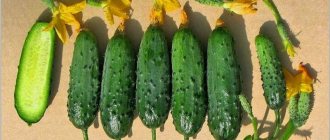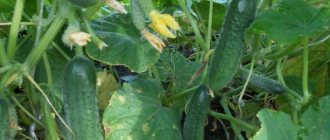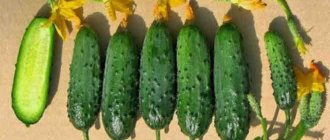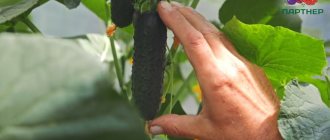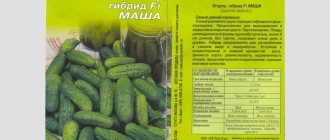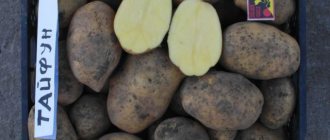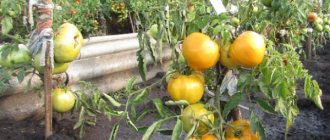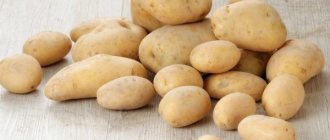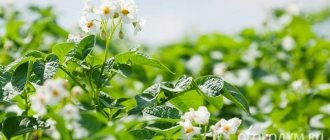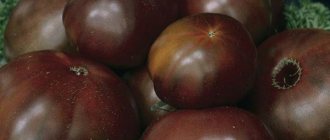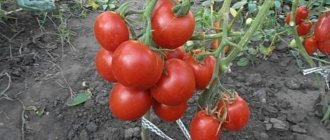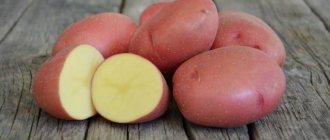Siberian Garland F1 is a relatively new hybrid bred by South Ural breeders. These cucumbers are distinguished by their extraordinary productivity - the fruits grow in “clusters”, there are a lot of them and they are very tasty. Let's find out how to plant and grow these cucumbers yourself.
Characteristics and features of growing cucumbers (this information is indicated by the manufacturer on the packet of seeds)
Ripening of cucumbers of the “Siberian Garland” variety
Description of cucumbers
The hybrid is distinguished by an unusual arrangement of fruits. Many cucumbers grow on one vine, resembling bunches of grapes.
Bushes
The plant is powerful, bushy, with abundant foliage. Stem height – 2 m or more. The bushes of “Siberian Garland” are no different from other hybrid cucumbers. There is a main stem around which the plant forms.
If you take a closer look at the bushes, you will notice the following features of the bushes:
- The stem is powerful and thick, up to 1 cm in diameter.
- Internodes are short - approximately 8 cm.
- At least three ovaries are formed in one node. The maximum number of ovaries reaches several dozen.
- The leaves are ordinary, five-lobed, up to 10 cm in diameter.
- The plant grows well in partial shade. Leaves often hide fruits and flowers so that they are inaccessible to view - the fruits have to be looked for under the foliage.
- The flowers are yellow and consist of 6 petals. Diameter – up to 4 cm.
Fruit
The fruits of the “Siberian Garland”, like all bunched cucumbers, are small, but there are a lot of them, and they grow in beautiful “clusters”. Features of the fruit:
- Length up to 8 cm, rare specimens grow longer.
- The diameter of the fruit is 10-15 mm.
- Weight – 20-50 g.
- Not prone to overgrowth.
- The color changes from the end to the base - the light green color gradually turns into dark green.
- The surface is covered with tubercles with small, non-spiny white spines.
- They have a characteristic cucumber aroma and a sweetish taste.
- The pulp is juicy, crispy, without bitterness or voids.
General characteristics
The Garland variety is not very popular, but experienced farmers predict a bright future for it as a variety, because the shoots and fruits of the plant look very attractive. Cucumber contains a large amount of vitamins.
According to the State Register, the variety can be grown in the following regions of the country:
- North Caucasian;
- Middle Volga;
- Central Chernozem;
- Volgo-Vyatsky;
- Central (including Moscow region);
- Northwestern;
- Northern.
Note!
Garland F1 differs from other species in that it has an exclusively female type of flowering.
The hybrid identity of the variety gives it the following number of differences:
- long harvest, in areas with warm climates - until early October;
- seeds for sowing next year should not be collected from your own harvest, because the grains have a weak structure in development;
- care requirements are reduced as much as possible;
- strong immunity to diseases typical of cucumbers;
- branching is small;
- The shoot length is average.
A plant of medium length with a powerful, fast growing stem of the parthenocarpic type. It stands out among other varieties due to its large size and dark green color. Heart-shaped leaves with an uneven, jagged edge. Flowering is abundant - each axil contains from 3 to 5 ovaries. There are no barren flowers at all.
The variety is characterized by a bouquet type of ovary formation. The fruits ripen from 35 to 45 days from the moment the sprouts appear. From one bush you get up to 35 pieces. The diameter of greens is 3-3.5 centimeters, length 10-12, weight 100-110 grams. The fruits are cylindrical in shape, dark green in color, have large tubercles and white fluff on the skin. Productivity is higher than the statistical average - 14–16 kg/m².
Characteristics of this hybrid
“Siberian Garland” cucumbers are self-pollinating bunch-type hybrids. It is relatively unpretentious and allows you to get a lot of cucumbers. Fruiting is extended over time, so the variety provides its owners with cucumbers until late autumn.
In bunch cucumbers, unlike ordinary cucumbers, several fruits are formed at once in one node - a “bunch” of fruits grows.
Productivity and fruiting
The originator reports that one bush of “Siberian Garland” is capable of producing 400-500 fruits – this is approximately 20 kg. From 1 sq. m harvest 35-40 kg of cucumbers.
The hybrid is early ripening, so the first cucumbers are harvested already 1.5 months after planting. If the correct agricultural technology is used, fruiting, once it begins, does not stop until the onset of cold weather. There are so many cucumbers and they grow so quickly that they have to be picked daily. If you skip harvesting, the development of new ovaries is inhibited.
Resistance to diseases and pests
“Siberian Garland F1” is highly resistant to many “cucumber” diseases. He is practically not affected:
- powdery mildew;
- peronosporosis;
- brown spotting;
- cucumber mosaic.
But this hybrid can be affected by fungal diseases - for example, gray and root rot. The cause of the disease is usually excessive dampness.
Advantages and disadvantages of a hybrid
Advantages of the “Siberian Garland”:
- High yields under any weather conditions and growing methods. The hybrid adapts to different climates.
- Self-pollination allows the hybrid to grow unhindered in closed ground.
- Long-term fruiting. In temperate climates it lasts until October, in the southern regions - until frost.
- Resistance to traditional cucumber diseases.
- No bitterness in taste.
Disadvantages of a hybrid:
- High cost of seeds. For a package of 5 seeds, sellers ask 70-120 rubles.
- Requires care, without which it is impossible to achieve high yields. But this feature is typical for any cucumber hybrid.
- It is necessary to collect the fruit daily to maintain abundant and long-term fruiting.
Description
“Garland” is a medium-sized, low-branched hybrid: unlike many varieties of cucumber, which have to be planted almost every week, “Garland” requires much less attention.
Medium sized leaf, dark green. I grew it next to the cucumbers "Masha" and "German". The difference is clearly visible after the third or fourth leaf: “Masha” has slightly smaller leaves, while “Herman” has lighter leaves.
Flowering is of the female type, from 3 to 5 flowers are formed in each leaf axil. Barren flower is rare.
The greens of “Garland” F1 are cylindrical in shape, dark green, with short light stripes and numerous medium-sized tubercles. The pubescence is white. The length of edible fruits is 10...12 cm, diameter - 3...3.5 cm, weight - up to 115 grams. The taste is excellent. Cucumbers are suitable for fresh consumption and canning.
How to prepare the soil and seeds?
“Siberian Garland F1” can be grown in any way - seedlings or seeds, in the open air and under cover. Whatever option is chosen, you need to prepare for planting - choose a place, make beds and prepare planting material.
Features of choosing a landing site:
- This hybrid grows best in partial shade. The hot sun has a bad effect on the growth and development of plants - they dry out and produce little fruit. If there is no natural protection, you will have to cover the plantings with a canopy. Another option is to plant sunflowers or corn on the sunny side.
- It is prohibited to plant peas next to cucumbers.
- Areas where pumpkins, beets or zucchini grew are not suitable. Cucumbers grow well after onions, white cabbage, potatoes and corn.
How to arrange a cucumber bed:
- Preparations since autumn. Hay, chopped straw, etc. are laid out on the selected area. The thickness of the layer is 9-14 cm. Fresh manure is placed on top, covered with film, and left in this form for the winter. Work continues in the spring. Remove the film, place the manure on top, and pour out a layer of humus. Dolomite flour is added to the acidified soil - it is mixed with humus (150 g per 10 l).
- Spring preparation. The area is dug up, rotted manure or compost is added and a layer of 10 cm thick is laid. Then pour in Nitrophoska (100 g per 1 sq. m). The soil is laid on top of the fertilizers in a layer of 10-15 cm. The bed is watered abundantly and covered with black film, trying to ensure tightness. Exposure under cover should last at least a week.
The next stage of preparation is sorting and germination of seeds. Having selected good seeds, they are soaked in a bioactivator and disinfectant. This saturates the planting material with microelements and prevents the development of fungal diseases. Table 1 shows the processing and preparation of seeds for germination.
Table 1
| Bioactive drug | How much to breed? | Holding time, h |
| Zircon | 1-2 drops in 300 ml of water | 8-18 |
| Azotophyte | 1 tsp. in 500 ml water | 1,5-2 |
| Epin | 1 ml in 2 liters of water | 24 |
| Vermisol | diluted in warm water 1:5 | 12 |
The treated seeds are placed on a damp cloth, covered with another, and placed in a warm place. After 1-2 days, sprouts appear.
To reject bad seeds, you need a salty solution - 50 g of salt is dissolved in a liter of water. The floating seeds are thrown away - they are not suitable for planting.
Description and features of agricultural technology of bunch varieties
The main feature of bunch-type cucumbers, even based on the name, is that they can form several ovaries at once, sometimes up to 10-15 pieces. Naturally, this cannot but advantageously distinguish such varieties from ordinary ones, since only due to this quality it is possible to collect several times more cucumbers from the same area. Indeed, statistics show that the number of fruits on one bush of the Garland F1 cucumber variety can reach 500 pieces or even more.
But such unique plants must also require unique growing conditions. On some level, yes, they do, but they are not so unique; at least, even a not very experienced gardener is quite capable of creating such conditions. Indeed, if the basic requirements of the culture are not met, the plants will not be able to “feed” their numerous ovaries in the garland and some of them will dry out.
To prevent this from happening, it is necessary to take into account and scrupulously implement all the following agrotechnical techniques for caring for cucumbers:
- Plant cucumbers as rarely as possible. In the greenhouse there are only 2 cucumber plants per square meter; in open ground, the number of cucumber plants planted per square meter can be doubled.
- It is important at the very early stages of growing cucumbers to make sure that they grow strong, healthy, have a powerful root system, strong stem and large leaves - that is, the plants must initially have the strength to feed so many ovaries. To do this, in open ground it is necessary to use warm ridges with a large layer of organic matter, preferably prepared in the fall. It is also necessary to use film shelters or tunnels to preserve heat, since cucumbers can show all their power only in high humidity and warm weather, without temperature changes. Perhaps because of this, in the middle zone and further north it makes sense to grow similar bunched cucumber varieties only in greenhouse conditions.
- It is advisable to collect greens as often as possible, maybe even every day, since overgrown cucumbers can inhibit the formation of new ovaries.
- Starting from the flowering period and the entire fruiting period, weekly fertilizing of cucumbers with complex organomineral fertilizer with microelements is required.
- In a greenhouse, the release of large amounts of carbon dioxide will have a beneficial effect on the yield of cucumbers. To do this, a barrel with fermented herbal infusion is placed in the greenhouse.
- It is mandatory to use a trellis for growing bunched varieties of cucumbers. To do this, two-meter posts are installed at the ends of the beds, between which wire is stretched in three places along the height. It is advisable to attach a mesh with large cells (size 10-20 cm) to the wire. Cucumber lashes are secured to this mesh. Planting in a garden bed in a greenhouse must be done in one line; in open ground, two-line planting of cucumbers can be used.
How to plant?
It doesn’t matter in what soil the cucumbers will grow - open or closed, warm beds are built for them. As soon as the soil warms up to +15°C, seedlings or seeds are planted.
Growing seedlings
The optimal time for sowing seeds for seedlings is the end of March. The procedure for growing seedlings:
- Disinfected and germinated seeds are planted in cups filled with universal substrate. Planting depth – 2.5-3 cm. You can prepare the soil mixture yourself:
- turf and forest land - 1 part;
- peat – 1 part;
- nitroammophoska – 1 tbsp. l. on a bucket.
- The glasses with seeds are covered with a film that allows light to pass through. Provide good lighting – turn on the backlight if necessary. The optimal temperature is from +25 to +28°C.
- Water containers with seeds every 3-4 days.
- To make the green mass grow more intensively, the seedlings are topped with urea (2 g per 1 liter of water). One plant needs about 100 ml of solution.
- When shoots appear, the film is removed. A week before planting, the seedlings begin to harden - they are taken outside or into the greenhouse every day.
The finished seedlings are taken out of the cups along with the soil. The bushes are placed in prepared holes and deepened to the lower leaves. The soil is carefully compacted. The substrate is watered twice - before planting and after planting.
Features of planting seedlings:
- Planting density – 2 seedlings per 1 sq. m.
- The distance between bushes is 10-15 cm.
- Row spacing is 12-15 cm.
If the soil has not been properly prepared in advance, then a handful of ash and 5 g of urea are placed in the holes before planting.
Seedless method
Cucumbers can be grown without seedlings - by direct sowing into the ground. This method is popular in regions where the soil warms up early - for successful germination, a temperature of about 18-20 degrees Celsius is needed. Minimum permissible value: +16°C. Weather conditions for the growth of cucumbers are critical. If the air warms up to +25°C during the day and drops below +15°C at night, cucumbers will not grow.
The best time to sow cucumber seeds in open ground is the end of May or the beginning of June. By this time, the soil will warm up and night temperatures will be at the desired level.
On trellises, the “Siberian Garland” bushes are formed with one stem - this saves space in the beds. Plants planted this way receive a lot of light and produce good yields.
Scheme for planting seeds in open ground:
- The interval between seeds is 5-7 cm.
- The distance between rows is 12-15 cm.
How to grow cucumbers yourself
The timing of planting seeds depends on the method of growing cucumbers . Direct sowing of seeds into the ground is carried out at the end of May–beginning of June, if the ground has warmed up to +15°C. Grains are planted for seedlings in the last ten days of April.
Interesting! The record cucumber was grown by a British gardener named Alfo Cobba. The length of the fetus was 91.7 cm.
The hybrid is recommended for growing in greenhouses . Garland is also successfully cultivated on balconies and loggias.
Direct planting of seeds in the ground
With the seedless method, the seeds are planted immediately in a permanent place of growth. The main advantage of this method is that you do not have to waste time and effort on growing seedlings. But there is a risk that not all seeds will sprout. In this regard, the seedless method is inferior to the seedling method, where the seedlings have already grown and take root in the ground without any problems. Also, cucumbers will begin to bear fruit later than when seedlings are planted.
The quality of the harvest is affected by the place where cucumbers are grown . Seeds are sown in non-acidic loamy or sandy loam soil. Crop rotation plays an important role. Good predecessors for cucumbers:
- beans;
- beans;
- garlic;
- onion;
- peas;
- cabbage;
- corn;
- potato;
- tomato.
Cucumbers are not grown repeatedly in the same place or after melons . Before sowing, the soil in the greenhouse is properly prepared. The soil is dug up and organic fertilizers are added to it. For this, rotted manure is used at the rate of 20 liters per 1 sq. m plot. The holes are dug at a distance of 30 cm from each other. 70 cm is left between the rows. The seeds are deepened into the soil by 2-4 cm.
Growing seedlings
For the Garland hybrid, the seedling method of growing is more suitable than the non-seedling method. The relative disadvantage of the method is that it is labor intensive and time consuming.
The best container for seedlings is peat tablets . Ready disinfected soil stimulates the development of seedlings. The tablets are placed in a container and filled with water. When they absorb water (after 15 minutes), the seeds are planted.
The seeds are deepened into the tablets by 1-2 cm, the latter are placed in a common box, which is covered with polyethylene or transparent glass and placed in a dark place. The substrate is periodically moistened from a sprayer.
When the seedlings germinate, the cover is removed. The seedlings are transplanted to a permanent location in late spring or early summer. The planting scheme is the same as with the seedless method: 30 cm are left between plants, and 70 cm between rows.
Growing and care
Cucumber is a moisture-loving plant. is especially important to provide the crop with moisture in hot weather . In the first stages of development, when the plants have not yet formed a powerful root system, cucumbers are watered at least 2 times a week, using 4-5 liters of water per 1 square meter. m. During the period of flowering and fruit set, the amount of water is increased to 10-12 liters.
If there is a lack of water for irrigation, the soil is mulched . This will significantly reduce the evaporation of moisture from the soil. The bed is mulched with a layer of 7 cm. For this, compost, peat, manure, pine needles or straw are used. Over-watering the crop is not allowed - this will lead to the development of infectious diseases.
The soil around the bushes is loosened and at the same time get rid of weeds , which take away nutrients and moisture from the plants. The event is carried out 12-24 hours after watering the cucumbers.
The frequency of loosening depends on the type of soil . When growing cucumbers on light sandy soil, loosening is not necessary. If the ground contains clay, then this procedure is carried out regularly. This will provide oxygen access to the root system, which will have a positive effect on the yield of cucumbers.
During the entire growing season, cucumbers are fertilized up to 6 times . For this purpose, mineral and organic fertilizers are used. The first feeding of plants is carried out at the beginning of flowering, subsequent ones - every three weeks.
Fertilizer methods:
- ash infusion (200 g per bucket of water);
- a solution of urea, potassium sulfate and superphosphate (1 tablespoon per 10 liters of water);
- infusion of chicken manure or mullein (in a ratio of 1:15).
At the initial stage, nitrogen fertilizers are applied. Subsequently, the concentration of potassium and phosphorus is increased. Many gardeners alternate organic and mineral fertilizers. Fertilizers are applied at the roots on moist soil. In cool weather, plants are not fed, as the crop does not absorb nutrients well.
The garland is grown vertically . To do this, the bushes are tied to a regular net or trellis. This makes caring for plants easier, and the crop receives more sunlight.
Features of cultivation and possible difficulties
The agricultural technology for growing Garland cucumbers is practically no different from caring for other cucumber crops.
Did you know? In some cities, monuments to cucumbers were erected (Lukhovitsy, Nizhyn). And on July 27, vegetable growers celebrate International Cucumber Day.
Diseases and pests characteristic of cucumbers
Since the Garland cucumber is a hybrid, the crop is little exposed to diseases, but a certain risk always remains . In such cases, plants are treated with special preparations. In order not to harm the cucumbers, the products are used strictly according to the instructions indicated on the packaging.
The most common diseases of cucumbers :
- Powdery mildew. The disease manifests itself as white spots on the foliage, which later spread to the entire plant. The leaves begin to dry out and fruiting stops. The damaged parts are torn off, and the bush itself is treated with fungicidal preparations, such as Ridomil Gold or Previkur. If the disease has spread to the entire plant, it is removed.
- Cladosporiosis . Brown cankers appear on bushes and fruits. To combat the disease, stop watering for 5 days and treat the crop with Fundazol (10 g per bucket of water). Infected areas are torn off.
- White rot . This is a viscous white consistency, due to which fruits and bushes begin to rot. Plants are treated by removing the affected parts and treating them with a special solution (10 g of copper sulfate, urea and zinc sulfate per 2 liters of water).
- Downy mildew. The foliage becomes covered with small yellow spots and begins to dry out. Subsequently, the disease spreads to the entire bush. Moisturizing and fertilizing are stopped for 3-4 days and the crop is treated with “Polycarbacin” (10 g of product per 5 liters of water).
On a note. The disease is fought in the first stages of its development, otherwise the plants will die and the diseases will spread to neighboring crops.
During the growing process, cucumbers are often attacked by pests . This mainly occurs during the fruiting period.
The most common pests :
- Aphid. Tiny green insects that eat foliage, causing the green mass to wilt. These bugs multiply quickly. Spraying plants with an ash solution helps against the pest (200 g of wood ash and 100 g of soap are mixed in 10 liters of water).
- Whitefly. Small white midges that suck the sap from plants and leave behind sooty fungus and wilted leaves. Midges are destroyed using garlic infusion (200 g of grated garlic or onion are stirred in 10 liters of water and allowed to brew for a day). The entire plant is treated with the prepared product.
- Spider mite. The pest is located on the back of the leaves, where it leaves behind a web. Small spiders bring various infections and eat foliage. The mite is destroyed by spraying the back of the leaves with a soap solution (200 g of grated laundry soap per bucket of water).
When pests are detected on plants, they are destroyed immediately , since insects quickly multiply and move to neighboring bushes.
Subtleties of care
Cucumbers are one of the most capricious and demanding crops. They love warmth, moisture, and feeding. “Siberian Garland” refers to hybrids, the care of which is justified by long and generous fruiting.
Loosening and weeding
Weeds are contraindicated for cucumbers, so the beds are regularly weeded. Humus, peat chips, and freshly cut greens are used as mulch. It is useful to loosen cucumber beds - this improves the supply of oxygen to the roots.
How to water?
Watering rules:
- The ideal time for watering is morning or evening. If drops of water fall on the leaves and the sun is shining, burns may occur.
- Before flowering, water once every 3-4 days. After the formation of the ovaries - once every 2-3 days.
- In hot weather, the beds are watered daily.
- Take warm water. Temperature – from +23 to +25°C. The water should stand for at least a day.
- The beds are watered with a watering can, from a hose, or drip irrigation is organized. Water is poured into the grooves between the plants; it is not recommended to water the roots - the water will wash away the soil from the roots, they will begin to dry out, and the nutrition of the plant will deteriorate.
- To increase air humidity in the greenhouse, barrels of water are placed near the beds. In hot weather, you can spray the inside of the greenhouse. It is also allowed to water the cucumbers from above - from a watering can, with a chalk solution.
The soil around the cucumber stem should remain dry to prevent the roots from rotting.
Fertilizer application
Siberian garland F1 needs frequent feeding - large harvests require “feeding”. Fertilizers are applied in different ways - organic and mineral. “Chemistry” can be replaced with folk remedies.
It is recommended to fertilize once a week, and their composition must be changed. Fertilizers are applied after watering. The frequency and composition of fertilizing according to folk recipes is in Table 2.
table 2
| When to deposit? | Compound |
| After germination and after the plants reach a height of 10-15 cm | Pour boiling water over 1/4 bucket of onion peels. Leave and water – 200 ml per plant. |
| Once a week. Fertilizing is alternated. |
|
| After fruit formation - every week | Sprinkle the soil with wood ash. Half a glass of ash is added to one plant. |
During the season, cucumbers need 4 fertilizing applications. The composition of the fertilizers is in Table 3.
Table 3
| When to fertilize? | Composition (per 10 liters of water) |
| 2 weeks after landing | Options:
|
| 2 weeks after the first feeding | Options:
|
| A week after collecting the first fruits | Options:
|
| 10 days after the third feeding | Spray with a solution of soda (30 g), urea (15 g) or an infusion of rotted hay. You can also add an infusion of manure or bird droppings. |
How are bushes formed?
The “Siberian Garland” leaves one stem to avoid overloading the plant. Features of formation:
- In the first 3-4 nodes, all flowers and ovaries are cut off.
- The side shoots are pinched off, leaving only the ovaries. The central shoot is wrapped around the top point of the trellis, and also pinched. Pinching side shoots helps to increase nutrition of the main stem. This accelerates plant growth and ensures high yields in the later stages.
- The best time to prune bushes is early morning.
- Sections are disinfected with copper sulfate (10-15 g per 1 liter) or crushed activated carbon.
- No more than 7-8 cm of shoots are removed at a time.
- When tying the whips to the trellises, you cannot place them unnaturally - twist or bend them.
- Dried leaves and shoots are immediately removed so that the plant does not waste nutrition on them.
Features of care
It is recommended to prepare the soil in the fall: add straw, pine needles, leaves, branches of bushes and trees. Cover the ground with film for the entire winter. After planting, regularly remove weeds, weed and loosen the soil. To get a good harvest, water with warm water at the root of the plant.
The variety is intended primarily for closed ground, with support for temperature conditions, and the bushes must be protected from temperature changes.
Do not get carried away with nitrogen-containing fertilizers, this can cause deformation and shedding. To maintain fruiting, fertilizers must be applied twice per period. For a bucket of water use:
- 1 tablespoon of potassium sulfur;
- 2 tbsp. urea;
- 1 glass of ash.
Fertilizing should be done in warm weather, after watering, in the morning or evening. Any variety of cucumbers likes to drink plenty of water. Before the planting period and the appearance of the first flowers, watering should be moderate. Depending on temperature conditions, moisturize every 3–5 days, up to 4 liters of water per bush. During the fruiting period, the amount of watering and moisture needs to be increased. You will have to moisten every 2-3 days, up to 8 liters of liquid per bush. On particularly hot days, monitor the soil, not allowing it to dry out and maintaining average moisture.
A full harvest can be harvested in 45-50 days. It is important to remember to do this every day to stimulate new growth. Cucumbers can be stored in the refrigerator unwashed; it is advisable to keep them in a cool, dark place before doing so.
Diseases and pests
If “Siberian Garland F1” cucumbers are properly cared for, they practically do not get sick. If the plants are healthy and strong, then pests are not particularly scary for them, but individual plants can still be affected. Table 4 shows cucumber pests and methods of controlling them.
Table 4
| Pest | What harm does it cause? | How to fight? |
| Fly miner | It lays eggs in leaves, and the larvae gnaw tunnels in them. | Spray with Aktara. Set up sticky traps. |
| Aphid | Settles on stems and on the underside of leaves. It sucks the juice out of the plant and weakens it. | Spraying with Fitoverm, adding 1 tbsp. l. liquid soap per 10 liters of water. Treat twice within 10 days. |
| Thrips | Very small insects that suck juices from plants. They spread viral diseases. | Spray with Fitoverm every 2 weeks. Set up glue traps. |
| Spider mite | The leaves are covered with a patina. They suck out the juices from the green parts of the plant. | Processed by Akarin, Oberon. These drugs are characterized by minimal toxicity to humans. |
When growing “Siberian Garland” in greenhouses, the probability of infection by fungal diseases is twice as high as in open ground. The fight is standard - treatment with fungicides, copper sulfate, wood ash solution.
Characteristics of the variety
Breeders presented the variety to the Russians in 2012. The young hybrid managed to gain fans.
Description of the plant
The hybrid is self-pollinating - its development does not require the presence of wasps, bees or other insects; the plant can be grown in a closed greenhouse. Although, this is not a prerequisite. According to the characteristics of the breeders, Siberian Garland F1 can grow in open beds, greenhouses, greenhouses, and balconies. Growing this hybrid on the balcony is quite convenient - one vine does not take up much space, and the yield is high.
It is better to grow these cucumbers on a trellis - the fruits do not rot, they are clearly visible, the ripening bouquet of Siberian cucumbers (and the variety ripens in a bouquet) will decorate the garden.
Important! If the variety is not grown on a trellis, the bush spreads out over the soil and requires more space to grow. In some cases, the lashes get tangled, break, and rot.
The fruits are small - from 8 to 12 cm, practically without thorns, smooth, with light tips.
The taste of the fruit is sweetish, the cucumbers are crispy and aromatic.
Due to their small size and high taste, hybrid cucumbers are universal in use:
- delicious fresh;
- great in pickling;
- you can pickle, salt, roll in salads - the fruits do not lose their elasticity and crispness, and add a wonderful taste and aroma to salads.
The cucumber hybrid ripens very quickly. If the plants were planted correctly, in the second ten days of June you can enjoy the first fruits.
Advantages of the variety
- in just 45 days you can taste the first harvest of cucumbers;
- begin to ripen very early;
- Fruiting continues for a long time;
- high yield - from 1 sq.m. you can collect 30-40 kg of fruits;
- the hybrid is self-pollinating, works wonderfully without the work of insects, and can be grown in greenhouses, greenhouses, where insects cannot always penetrate;
- bushes resist return frosts well;
- in one ovary there are up to 15 cucumbers - a kind of garland is created;
- they resist well to a number of diseases - powdery mildew, tobacco mosaic, brown spot, downy mildew;
- wonderful taste of cucumbers.
Important! One of the most important advantages is the shade tolerance of the variety. Even if the garden bed is not placed in the sunniest place, the harvest will be rich.
Flaws
The description of the variety will be incomplete if we talk only about the advantages. Two disadvantages of the variety can be noted:
- Since it is a hybrid, gardeners will not be able to collect their own seeds. The seeds will not retain their varietal identity; the best qualities of the variety may be lost. But cucumber seeds are inexpensive.
- The bush will have to be formed. The plant is so strong and powerful and produces many shoots that it will take a lot of time and effort to allow all the cucumbers to ripen. It is better to control the process by correctly forming the bush.
The disadvantages compared to the advantages look completely unconvincing. This is probably why many gardeners prefer this variety to many others.
Harvest and storage
The harvest begins around the second half of June. Rules for collecting and storing Siberian Garland cucumbers:
- The fruits are collected in the mornings or evenings. Ideally - every day.
- Cucumbers are not torn off, but cut with a sharp knife or scissors. The fruits are left with “tails”. Do not use force when picking cucumbers, pull or pull branches.
- Store fresh cucumbers for 7-10 days, placing them in the refrigerator or in a bag covered with a cloth moistened with water. Moisten the napkin as needed.
- Before storing the fruit, they are cooled - this helps prevent the formation of condensation, which causes rot to develop.
- Cucumbers can be stored in the basement at a temperature of +7-10°C and a humidity of 80-90%. They are stored in wooden or plastic boxes covered with plastic film.
Advantages and disadvantages of Garland cucumbers
- This variety has a large list of advantages:
- early maturation;
- self-pollinating;
- shade tolerance;
- the ability to grow crops in apartment conditions;
- ease of care;
- resistance to common diseases;
- high productivity;
- keeping quality and transportability of fruits.
- The disadvantages include the following:
- mandatory formation of lashes;
- need for tying;
- Damage to the crop due to irregular harvesting of fruits.
What other “Garlands” are there?
There is another hybrid related to bunch cucumbers - Garland F1. It was registered in the State Register in 2010. Features of this hybrid:
- early ripening - bears fruit 41-43 days after emergence;
- powerful, weakly branched stems;
- tolerates shade well;
- does not require artificial pollination;
- in one node - 5-6 ovaries;
- cucumbers of small length - 12-14 cm, cylindrical in shape;
- weight – 110-120 g;
- the surface is pimply;
- the taste is good, the purpose is universal;
- high resistance to diseases.
Garland cucumber variety - domestic development
Garland cucumbers have relatively recently appeared on the plots of those who like to experiment with new varieties. A large number of young cucumbers hanging like a garland from the plant is a delight. Many people liked the vitamin fruits themselves.
The list of tolerance areas for growing the variety is wide. This suggests that the plant develops well in different climatic conditions. Garland is zoned in the following regions:
- Northern;
- Northwestern;
- Central (including the Moscow region);
- Volgo-Vyatsky;
- Central Chernozem;
- Middle Volga;
- North Caucasian.
The wonderful Garland variety was created by domestic scientists. The developers are the breeding and seed production and scientific research institutes for vegetable growing in protected soil. It was included in the State Register in 2010, but has already gained fame among gardeners.
Garland cucumbers are a native variety
By the way, in addition to the Garland variety, there is another variety, Siberian Garland. But this is not the same plant, the Siberian Garland appeared a little later and is the brainchild of the Chelyabinsk breeding station.
Reviews from gardeners
★★★★★
Olga Sh., amateur gardener, Novosibirsk region. I bought the seeds on the advice of the sellers.
I was interested in the picture - cucumbers growing in clusters like grapes. We always have a problem with cucumbers; our weather is difficult and our harvests are small. The new product made me happy - now I can make a lot of preparations. The cucumbers are small - just right for rolling. It’s delicious to eat them fresh; it’s interesting that they never taste bitter. The downside is the need to buy seeds, since it is a hybrid. ★★★★★
Alexey N., summer resident, Moscow region. I have been growing Siberian garland for 2 years now.
It was advertised as a super productive variety. I didn't notice any special yield. The difference from ordinary cucumbers is that the fruits grow from one bosom in several pieces. It’s strange that the fruits grew smooth, although according to the description they should be pimply. Hide
Add your review
Siberian garland is a high-yielding hybrid that promises long and abundant fruiting. But to get a decent harvest, gardeners need to spend a lot of time and effort.
0
0
Copy link
Description of the cucumber Siberian Garland F1
This miracle of selection was developed within the walls of the experimental Chelyabinsk station, which is located in the city of Miass. The cucumber hybrid Siberian Garland f1 is part of a series called the “Magnificent Five”. Each of its representatives received rave reviews from gardeners, but Garland received the most of them. The hybrid was created in 2013 and simply did not have time to pass the tests to be included in the State Register of Breeding Achievements, but, undoubtedly, it is one - just read the description of the Siberian Garland f1 cucumber and compare the characteristics with other varieties and hybrids.
Description of the plant
The most suitable epithets for this plant are “strong” and “powerful”:
- the lashes of the Siberian garland cucumber f1 are thicker than a pencil and can grow up to 2 m and higher;
- they produce side shoots, like all pumpkin ones, but this cannot be allowed for this hybrid - radical formation is necessary;
- numerous leaves reach 10 cm in diameter;
- internodes are short, no more than 8 cm long;
- from each node hangs a whole bunch of cucumbers, up to 5 in number, after harvesting new ones grow, and the total number of cucumbers reaches 20, and this is in each node;
- The root system is powerful, it can feed a huge number of fruits.
Description of fruits
The size of the fruits of the Siberian Garland is close to gherkins - no more than 8 cm, and with regular daily harvests - about 5. Their color is rich, green, which gradually turns into a salad color towards the top, diluted with short light stripes.
The tubercles are very small, but frequent. There is also light light pubescence. The not rough, but durable skin allows the fruit to be stored for more than a week. But usually they are eaten earlier - the typical cucumber slightly sweet taste is too good. And the pronounced aroma will not leave anyone indifferent.
Very small seeds are hidden in the crispy juicy pulp - like all parenocarpics, they do not ripen, so the fruits hang on the vines for a long time without outgrowing. But this cannot be allowed - the growth of neighbors is inhibited.
This cucumber is good in any form: fresh, salted, pickled. There will be no voids in it, and the attractive crunch will remain.
